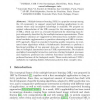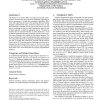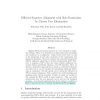252 search results - page 34 / 51 » Using OWL to model biological knowledge |
ECML
2006
Springer
13 years 11 months ago
2006
Springer
Multiple-instance learning (MIL) is a popular concept among the AI community to support supervised learning applications in situations where only incomplete knowledge is available....
BMCBI
2007
13 years 7 months ago
2007
Background: Quantifying cell division and death is central to many studies in the biological sciences. The fluorescent dye CFSE allows the tracking of cell division in vitro and i...
ICSE
2010
IEEE-ACM
13 years 9 months ago
2010
IEEE-ACM
The feature list of modern IDEs is steadily growing and mastering these tools becomes more and more demanding, especially for novice programmers. Despite their remarkable capabili...
ICDM
2006
IEEE
14 years 1 months ago
2006
IEEE
There is a need to develop methods to automatically incorporate prior knowledge to support the prediction and validation of novel functional associations. One such important sourc...
CONSTRAINTS
2008
13 years 7 months ago
2008
Aligning DNA and protein sequences is a core technique in molecular biology. Often, it is desirable to include partial prior knowledge and conditions in an alignment. Going beyond...



